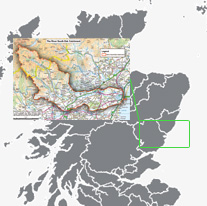Pollution
We can consider that there are two main types of pollution.
- Point source pollution is pollution that can be traced to one specific place, for example, the end of a pipe.
- Diffuse pollution is a gradual and often unnoticed seepage of polluting material from a number of sources into the environment, making it harder to define, find and control.
On their own these releases can be of little significance, but together they can lead to a major deterioration in the quality of water.
As the South Esk does not flow through an industrial or heavily built-up area, it has escaped from much of the contamination and pollution that many urban rivers suffered from in the past. Indeed, the wildlife that it supports (from salmon, otters and water voles, to freshwater pearl mussels to name a few) shows just how unpolluted it is. So, it is not surprising that much of the area has recorded good or high ecological status by monitoring carried out by SEPA.
However, certain parts of the area have been recorded as being of poor or moderate ecological status as a result of nutrient enrichment which is usually due to too much of the chemical nutrients nitrogen, phosphorous, or both.
Nutrient enrichment and too much sediment in watercourses from farming and so on can lead to a number of problems such as:
- Harsher treatment needed before the water can be used as drinking water;
- The threat of diseases carried in water from sewage contamination (animal and human);
- The smothering of freshwater pearl mussel beds and spawning gravels; and
- More general effects on river life and habitat such as algal blooms which happen regularly at Montrose Basin,



